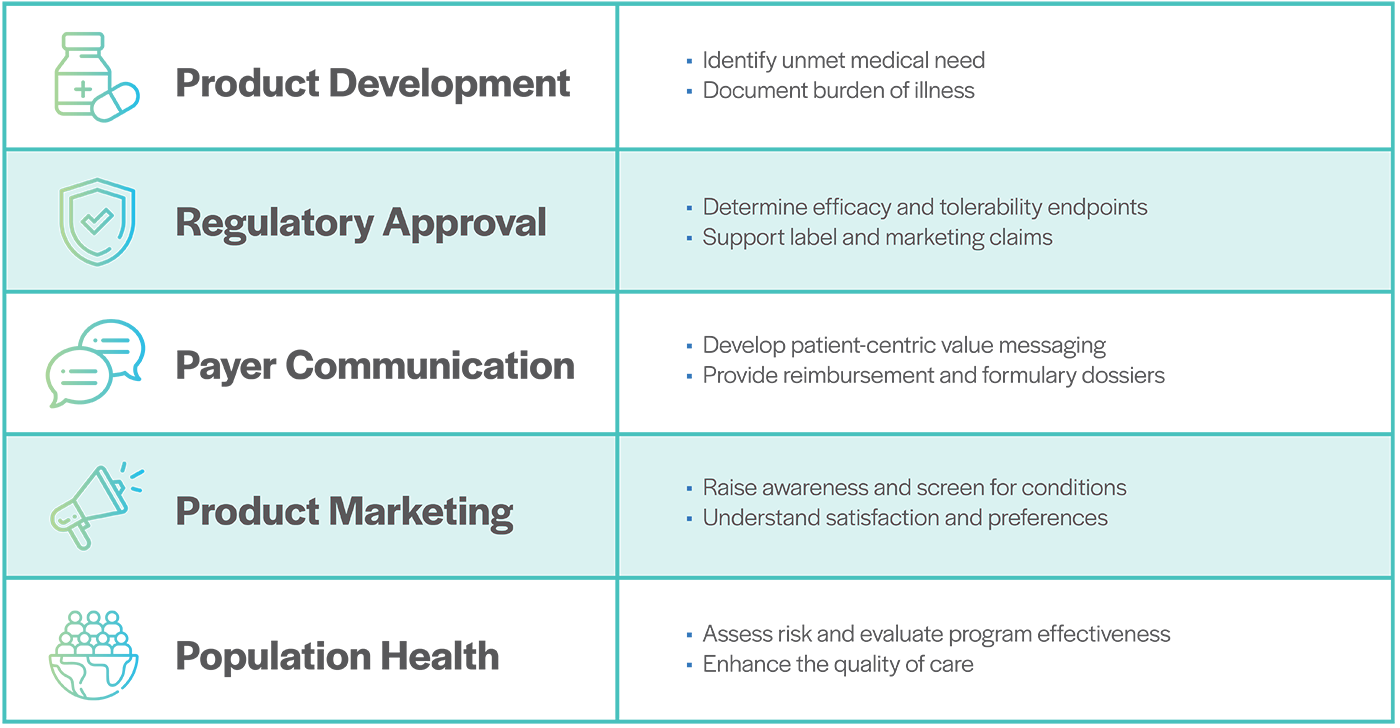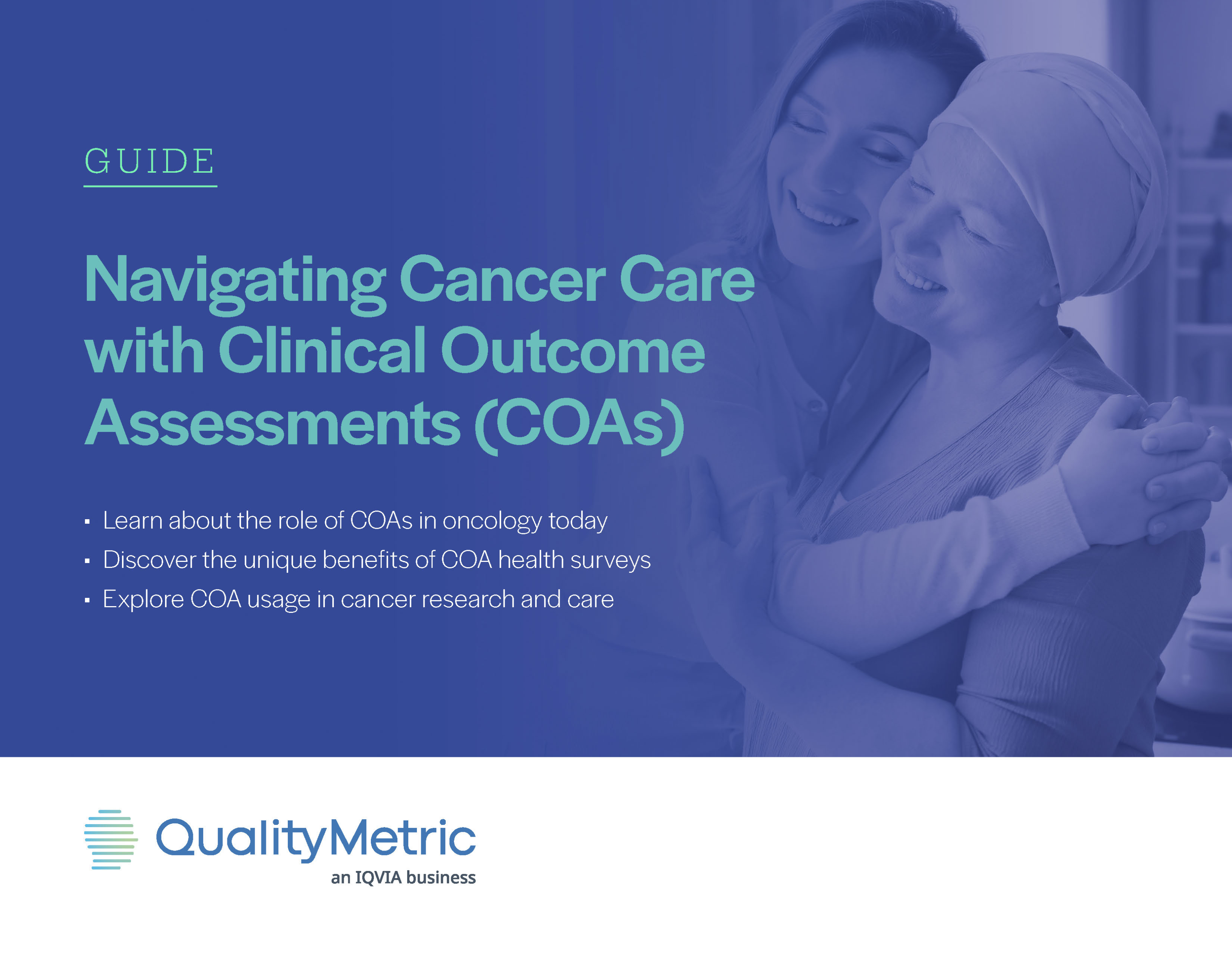Clinician-reported outcome (ClinRO) measures are the gold standard for assessing patient experiences in clinical research. Over the years, routine care and clinical research have benefitted from incorporating data derived directly from real patient experiences through patient-reported outcome (PRO) measures, also known as PROMs. PRO instruments, which are a type of eCOA, are increasingly valued in clinical trial settings and treatment delivery, where information from the patient’s perspective on symptoms, health-related quality of life and other aspects of experiencing a disease or condition can support a variety of healthcare initiatives.
As manufacturers develop medical devices, pharmaceutical companies research new therapeutics, and physicians update clinical data registries, patient-reported outcome measures fill an important gap in creating a more complete picture of the impact healthcare has on patient populations.
Learn more about patient-reported outcome measure guidelines, from designing and analyzing studies and interpreting the voice of the patient to considering how PROs can support research efforts in your area of the healthcare ecosystem.
Defining Patient-Reported Outcome Measures

Patient-reported outcomes (PROs)—a type of clinical outcome assessment (COA) or electronic clinical outcome assessment (eCOA) solution—are health outcomes reported by patients or study subjects themselves without interpretation by clinicians, caregivers or other observers. Patient-reported outcome measures (PROMs) are the specialized instruments used to measure PROs; they’re tools designed to collect data from patients to assess their quality of life, as well as functional health and well-being. PROMs typically come in the form of a self-directed, self-completed questionnaire or survey standardized and validated to ensure data captured is relevant, reliable and useful for evaluating the nuanced effects of diseases, conditions, treatments and care programs.
Electronic patient-reported outcomes (ePROs) meet the healthcare community’s increased need for electronic-friendly assessments that make administration and completion more accessible for patients. PRO surveys that are available in a validated single-item format (SIF) can be delivered across a range of supporting electronic devices, such as smartphones, handheld tablets, and can even be programmed to prompt patients with questions one at a time for an easy, straightforward user experience.
Understanding Patient-Reported Outcome Measure Benefits
The possibilities of PROs are endless. Gathering data at the individual level, health service level or health system level1 can illuminate sometimes unseen factors and unmet needs contributing to patient progress as they receive treatments and therapies. PRO tools also help researchers and clinicians consider the severity and frequency of symptoms to form a more robust view of patients’ experiences.
The Possibilities of PROs

Healthcare providers can learn what matters most to patients through PROMs and use that information to communicate more effectively during care delivery. They can also chart patient recovery, make informed care decisions and review the performance of their colleagues.
With fit-for-purpose PRO surveys, healthcare professionals can leverage tailored questions alongside general PROMs to examine patient health status as it’s affected or influenced by a particular condition or disease. Collecting data with disease-specific patient-reported outcomes in clinical trials is particularly valuable for rare disease research, when each patient’s point of view can significantly expand our understanding of disease onset, presentation and health impact and help document the short- and long-term outcomes of vital new treatments.
Common Disease-Specific PRO Surveys
Drug development companies and medical device manufacturers may use PRO insights to fuel product lifecycles by generating evidence for their treatment, supporting label claims and meeting patient preferences.
Leveraging PROs in Product Lifecycles

PROM Guidelines and Best Practices

Patient-reported outcome measures function as extremely beneficial primary or secondary endpoints in many healthcare industry applications: drug development clinical research, pharmacoeconomic analysis, direct-to-consumer marketing, disease and population management, risk assessment, cost prediction and consumer-directed healthcare. But knowing how to implement PRO instruments and accurately interpret responses is key to obtaining the results you’re looking for.
eCOA measures like ePROs are known to contribute to higher patient engagement in clinical trials as they allow studies to incorporate familiar technology and apps that make measures more accessible to patients. But trial designs that intend to employ ePROs should first consider whether enough of the study participants own a compatible device, have consistent internet access or need electronic device guidance to successfully comply with PRO requirements.
Patient functional limitations may also impact the quality of data that teams achieve through PRO tools. Studies evaluating patients with disabilities that limit sight or mobility, for example, may want to explore other options for administering patient-reported outcome measures so participants are more likely to provide accurate data. If validated as comparable to results from traditional instruments, interactive voice-response systems and picture-based response scales can be used to increase access.
Well-designed PRO programs will pay particular attention to the target demographic, background, culture, as well as language and literacy of the patients it will reach to proactively address any potential challenges a study may encounter with data collection. Several factors can influence patient responses, which can lead to inconsistent and inconclusive results. To pursue global clinical studies, or simply ensure an effective PRO program with high-quality data, teams can work with a PRO provider that supplies strategic guidance in selecting measures or developing novel instruments, translating and linguistically validating their content and supporting their use from implementation to interpretation.
QualityMetric is one such provider. Our experience helping companies meet modern patient-reported outcome measure guidelines for life science companies spans multi-phase studies and multinational research efforts. We provide reliable measurement tools and strategic consulting services to help researchers and clinicians make confident decisions with meaningful insights from the patient’s perspective.
Browse our suite of PRO health surveys to learn more about PRO solutions and explore their use in your research or clinical practice.
References
- Ahern, S, Ruseckaite, R, Ackerman, I.N. Collecting patient-reported outcome measures. Intern Med J. 2017;47:1454-1457. https://doi.org/10.1111/imj.13633.
 NEW COAS IN ONCOLOGY GUIDE
NEW COAS IN ONCOLOGY GUIDE




